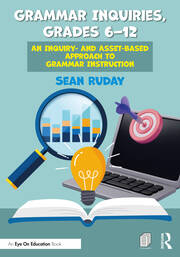Link Grammar Instruction to Real-World Situations
By Sean Ruday

These questions are at the heart of meaningful conversations about grammar that we educators can have with our students. With these questions and their related ideas in mind, I’ve been working in schools and in professional development workshops on an approach to the teaching and learning of grammar called grammar inquiries.
I’m excited to share with you the key ideas and insights about grammar inquiries. In this piece, I discuss what grammar inquiries are, why they’re important, and ways teachers can put them into action in their classrooms.
What Are Grammar Inquiries?
Grammar inquiries are opportunities for students to apply the principles of inquiry-based learning to their experiences with grammar.
In inquiry-based learning, students investigate essential questions, which McTighe and Wiggins (2013) describe as questions that are open-ended, thought-provoking, and aligned with higher-order thinking. These questions facilitate deeper learning and call for critical thinking.
Grammar inquiries apply the idea of essential questions to the teaching and learning of grammar by investigating questions that help students think deeply about the importance of a grammatical concept.
In a grammar inquiry students will investigate questions such as “How are prepositional phrases important to the communication in our everyday lives?” and “How do strong verbs make the texts we encounter outside of school as effective as possible?” These are both questions that seventh-grade classes I worked with investigated recently.
Why Are Grammar Inquiries Important?
Grammar inquiries go beyond traditional grammar methods that focus on out-of-context instruction and worksheets. When students conduct grammar inquiries, they think in deep, thoughtful ways about why a grammatical concept matters to effective communication. They find authentic uses of grammatical concepts and consider the importance of those concepts to the real-world situations where they’re used.
This helps students think in metacognitive ways about the significance of the grammatical concept on which they’re focusing. It takes students past surface-level learning as they consider the impact of a grammatical concept.
For example, if students are investigating the importance of prepositional phrases to everyday communication, they will use their knowledge of the features and attributes of prepositional phrases to identify real-world examples of this concept and reflect on the importance of those examples.
How Can Teachers Put Grammar Inquiries into Action?
Now, let’s explore how you can put grammar inquiries into action in your classroom. These are the steps I have followed when conducting grammar inquiries with students.
Step One: Build the Foundation for Inquiry-Based Grammar Learning
Before students begin their grammar inquiries, they’ll need strong foundations in the grammatical concept they’ll be studying. To build these foundations, I recommend first conducting an introductory mini-lesson on the focal concept. In these mini-lessons, I discuss the key features of the focal concept, provide examples of its use, and share some introductory points about the importance of the concept.
After conducting this mini-lesson, I share some published mentor text examples to help deepen students’ awareness of how the concept is used. Following this information about concept, I explain to students that they will be looking for examples of this concept in their out-of-school lives and reflecting on its importance to the situations in which it is used. I introduce the inquiry’s essential question and explain that we will be working in our upcoming classes on identifying and analyzing real-world examples.
Step Two: Show Students Examples of Authentic Grammatical Concepts
In this step of the grammar-inquiry process, I model for students what it looks like to find an example of a grammatical concept in my out-of-school life. For example, when working with seventh-graders who were conducting grammar inquiries on strong verbs, I shared examples of strong verbs from a conversation I had with one of my children about a Pittsburgh Steelers football game.
Step Three: Reflect with Students on the Concepts’ Importance
After I share authentic examples from my own life of a grammatical concept, I talk with students about the importance of that concept to the text in which it was used. For instance, after sharing with my students strong verbs like “rushed” and “tackled” that I identified in a conversation about a Steelers game, I led students through a reflective discussion about why this verbs are strong and how they enriched our conversation.
No matter what concepts you’ve discussed or where they were used, I recommend using these reflective discussions to talk with students about why the creator of the text may have used the concept and how the text would be different if that concept wasn’t used. In the case of strong verbs, would the reader or listener be less engaged with weaker verb choices? Would they be more likely not to remember key parts of our writing or conversation?
These questions can help students think deeply about the importance of real-world uses of grammatical concepts.
Step Four: Help Students Identify and Analyze Authentic Examples
At this point in the grammar inquiry process, students move to truly embarking on their own grammar inquiries. There are three related activities for students to do that will help them:
(1) Review the essential question they’ll explore in their inquiry;
(2) Identify authentically used examples of the grammatical concept on which they’re focusing, and
(3) Analyze the importance of the grammatical concept they identified to the context in which it was used.
As students identify and analyze these authentic examples, I like to confer with them individually, talking with them about why the example they found represents the focal concept and the importance of the example to the situation in which it was used.
For example, if a student found a strong verb in a song lyric, I would talk with them about why that lyric contains a strong verb and why the strong verb is important to the meaning and the impact of the song.
Step Five: Create Opportunities for Students to Share Their Findings
Once students have completed their grammar inquiries by identifying authentic examples of grammatical concepts and reflecting on the importance of those concepts, I like to create opportunities for them to share the results of their inquiries.
I ask students to give presentations that describe the following information:
(1) Their response to the inquiry’s essential question;
2) The authentic example of the focal grammatical concept they identified, and
3) Their analysis of the importance of that grammatical concept to the text in which it was used.
These events can make the grammar inquiry experience meaningful for students and provide them with additional motivation for their grammar inquiry work. In addition, these presentations are aligned with the values of grammar inquiries since a key goal of grammar inquiries is highlighting how grammar is not just found in textbooks and on worksheets, but in authentic, real-world communication.
Closing Thoughts
By taking an inquiry-based approach to grammar instruction, we can center our students and prioritize their authentic experiences with language. When students consider essential questions on the importance of grammatical concepts to their out-of-school lives, they can engage with grammar in meaningful ways.
Grammar is no longer “boring.” Grammatical concepts don’t just exist in textbooks and on worksheets: they are all around us, helping us communicate in meaningful ways. Grammar inquiries capitalize on this and make grammar work meaningful, authentic, and student-centered.
References
McTighe, J., & Wiggins, G. (2013). Essential questions: Opening doors to student understanding. ASCD.

This piece is adapted from his most recent book, Grammar Inquiries, Grades 6 – 12: An Inquiry- and Asset-Based Approach to Grammar Instruction (Routledge/Eye On Education, 2024).






























